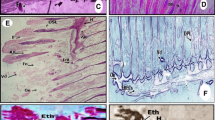Abstract
This study was carried out to investigate the histopathological changes of gill, kidney and liver of Persian Sturgeon and Stellate in response to various sublethal concentration of ammonia. The sublethal doses were determined after a lethal pre-test and then the experiment was done in six treatments with three replicates for both species. In Persian sturgeon, the treatments were including 5, 7, 9.7, 13.2, 18 and 25 mg/l ammonia. In stellate, the concentrations of 5, 6.23, 7.76, 9.66, 12.04 and 15 mg/l ammonia were considered as treatments. Also, one group without ammonia was considered as control for each experiment. The histopathological investigations were done after 96 h exposure. According to our observations, a range of histopathological alternations were found in gill, liver and kidney of both examined fish. The alternations of gill tissue were lamellar necrosis, hyperplasia, lamellar adhesion, haemorrhage, swelling of gill lamellae. Severity of these alternations was dose-dependent and was significantly higher in Persian sturgeon than in stellate. The degree of histopathological alternations of liver did not show a regular pattern between treatments in both species. These alternations were hyperemia, bile record, cell necrosis, cell atrophy, fatty degeneration and cloudy swelling. The signs of kidney alternations intensified with increasing of ammonia concentration in both species. The signs such as hyperemia, vision tissue degeneration, cell necrosis, dilatation of Bowman’s space. In conclusion, our results showed that ammonia in concentration of more than 5 mg/l have more adverse impacts on gill, liver and kidney tissues.






Similar content being viewed by others
References
Arellano JM, Storch V, Sarasquete C (2004) Ultrastructural and histochemical study on gills and skin of the Senegalsole, Soleasene galensis. J Appl Ichthyol 20:452–460
Colt JE, Armstrong DA (1981) Nitrogen toxicity to crustaceans, fish, and molluscs. In: Allen LJ, Kinney EC (eds) Proceedings of Bio Engineering Symposium For Fish Culture. Fish Culture Section of the American Fisheries Society FCS Publ, pp. 34–47
Evans DH, Piermarini PM, Choe KP (2005) The multifunctional fish gill: dominant site of gas exchange, osmoregulation, acid-base regulation, and excretion of nitrogenous waste. Physiol Rev 85:97–177
Garcia-Santos S, Monteiro SM, Carrola JE, Fontainhas-Fernandes A (2007) Alterac¸ oes histologicas em branquias de tilapia nilotica Oreochromis niloticus caused pelocadmio. Arq Bras Med Vet Zootec 59:376–381
Harris JO, Maguire GB, Edwards S, Hindrum SM (1998) Effect of ammonia on the growth rate and oxygen consumption of juvenile greenlip abalone, Haliotis laevigata Donovan. Aquaculture 160:259–272
Hinton DE, Baumann PC, Gardner GR, Hawkins WE, Hendricks JD, Murchelano RA, Okihiro MS (1992) Histopathologic biomarkers. In: Hugget R, Kimerle R, Mehrle P, Bergman H (eds) Biomarkers—biochemical, physiological and histological markers of anthropogenic stress. Lewis Publishers, Boca Raton, pp 155–195
Nascimento AA, Araujo FG, Gomes ID, Mendes RMM, Sales A (2012) Fish gills alterations as potential biomarkers of environmental quality in a eutrophized tropical river in south-eastern Brazil. J Vet Med 41(3):209–216
Oliveira Ribeiro CA, Vollaire Y, Sanchez-Chardi A, Roche H (2005) Bioaccumulation and the effects of organochlorine pesticides, PAH and heavy metals in the eel (Anguilla anguilla) at the Camargue Nature Reserve, France. Aquat Toxicol 74:53–69
Schwaiger J, Wanke R, Adam S, Pawert M, Honnen W, Triebskorn R (1997) The use of histopatological indicators to evaluate contaminant-related stress in fish. J Aquat Ecosyst Stress Recover 6:75–86
Smart GR (1978) Investigations on the toxic mechanisms of ammonia to fish gas exchange in rainbow trout (Salmo gairdneri) exposed to acutely lethal concentrations. J Fish Biol 12:93–104
Teh SJ, Adams SM, Hinton DE (1997) Histopathological biomarkers in feral freshwater fish populations exposed to different types of contaminant stress. Aquat Toxicol 37:51–70
Temmink JHM, Bouwmeister PJ, de Jong P, Vanden Berg JHJ (1983) An ultrastructural study of chromate-Induced hyperplasia in the gills of rainbow trout (Salmo gairdneri). Aquat Toxicol 4:165–179
Thophon S, Kruatrachue M, Upathan ES, Pokethitiyook P, Sahaphong S, Jarikhuan S (2003) Histopathological alterations of white seabass, Lates calcarifer in acute and subchronic cadmium exposure. Environ Pollut 121:307–320
Vigliano FA, Aleman N, Quiroga MI, Nieto JM (2006) Ultrastructural characterization of gills in juveniles of the argentinian silverside, Odontesthes bonariensis (Valenciennes, 1835) (Teleostei: Atheriniformes). Anat Histol Embryol 35:76–83
Wester PW, Canton JH (1991) The usefulness of histopathology in aquatic toxicity studies. Comp Biochem Physiol (C) 100:115–117
Zeeman MG, Brindley WA (1981) Effects of toxic agents upon fish immune systems: a review. In: Sharma RP (ed) Immunologic considerationsin toxicology. CRCPress/Lewis Publisher, Boca Raton, pp 1–60
Author information
Authors and Affiliations
Corresponding author
Rights and permissions
About this article
Cite this article
Banihashemi, E.S., Khara, H., Pajand, Z. et al. Histopathological study of gill, kidney and liver of Persian Sturgeon (Acipenser persicus Borodin, 1897) and Stellate (Acipenser stellatus Pallas, 1811) exposed to sublethal concentration of un-ionised ammonia UAN. J Parasit Dis 40, 1443–1450 (2016). https://doi.org/10.1007/s12639-015-0710-0
Received:
Accepted:
Published:
Issue Date:
DOI: https://doi.org/10.1007/s12639-015-0710-0




